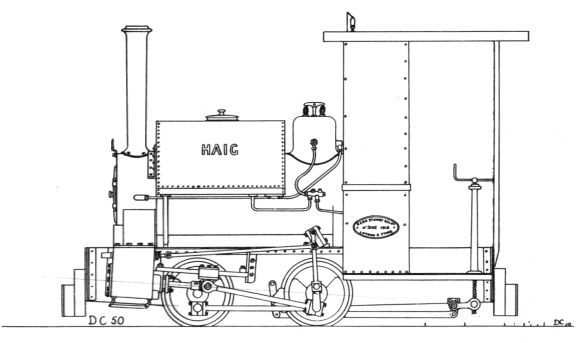
| THE INDUSTRIAL RAILWAY RECORD |
© DECEMBER 1964 |

THE KERR STUART
“WREN” CLASS
by GEOFFREY HORSMAN
drawing by DOUG CLAYTON
Of the several standard types of industrial locomotives built by Kerr, Stuart & Co. Ltd., the "Wren" was the smallest[1] in size yet the largest numerically. No fewer than 163 were produced before the Company closed down in 1930, and four more were built by the Hunslet Engine Co. Ltd. in Leeds after they bad acquired Kerr Stuart‘s goodwill. The whole design of the "Wren" could be said to be typical of Kerr Stuart‘s standard narrow gauge locomotives of the period. Probably no other British locomotive builder produced so many or such a variety of standard narrow gauge locomotives as did Kerr Stuart, with the "Brazil", ‘Darwin", "Haig", "Huxley", "Matary", "Midge", "Sirdar", ‘Skylark", "Tattoos, "Waterloo" and "Wren" classes.
1 No. 691 appears to have been the smallest of all Kerr Stuart‘s locomotives − 4 in. by 6 in. cylinders and weighing only 32 cwts. − but the "Wren" was the smallest of the standard types.
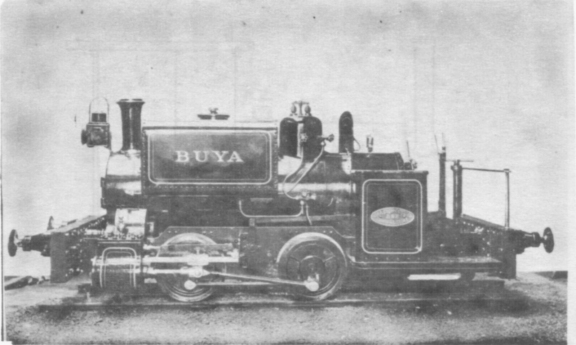
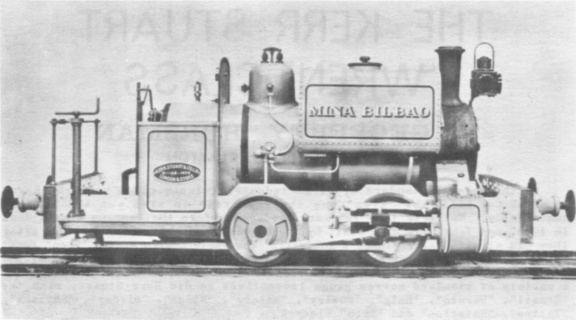
|
Two views of the "Buya" class. |
| Upper – 868 of 1904, BUYA, 75 cm gauge. |
| Lower – 1106 of 1909, MINA BILBAO, 75 cm gauge. |
The origin of the "Wren" class can be traced back to No. 850, a 2 ft. 1¾ in. gauge 0−4−0 saddle tank supplied to the Southend Gas Company on 24 December 1903. From this design two further locomotives (nos. 868 and 869) were developed for 75 cm gauge and despatched to Bilbao, Spain, on 30 July 1904, to the order of Chavarri Hermanos, who owned ironstone mines in the vicinity. The development became known as the "Buya" class and further examples, all differing in detail, were built. These included no. 874 (3 ft. 3 in. gauge) which was fitted to burn oil fuel and despatched to the Bundi Tin Dredging Co. Ltd., via Singapore, on 11 January 1905; no. 889 (3 ft. gauge) to the Port & Docks Board, Dublin, on 17 April 1905; no. 1106 (75 cm gauge) to Chavarri Hermanos on i6 December 1909; and No. 4405 (3 ft. 3 in. gauge) to the Bundi Tin Dredging Co. Ltd. on 28 November 1927.
Generally speaking the "Buya" locomotives were built with short chimneys and very low weather screens. However, No. 888 (2 ft. 6 in. gauge) emerged with an awning and weather screen similar to those fitted to the "Brazil" class 0−4−2 saddle tank; it was also provided with a tall chimney. Instructions to the Stoke-on-Trent works from Kerr Stuart‘s London office on 1 February 1905 regarding No. 888 were that ‘we wish to make this with the awning and weather board a standard type of engine to be called "Wren". Therefore please take photo with this name painted on, before final painting.‘ No. 888 was subsequently despatched as "No.1" to the Admiralty, Royal Victoria Yard, Deptford, London, on 28 March 1905.
Dimensions
| Cylinders | 6 in. by 9 in. |
| Wheel diameter | 1 ft. 8 in. |
| Wheelbase | 3 ft. 0 in. |
| Tubes | 35 of 1¾ in. dia. |
| Working Pressure | 140 lbs./sq. in. |
| Water Capacity | 87 gallons |
| Fuel Space | 5.5 cubic ft. |
| Heating Surface (tubes) | 72.1 sq. ft. |
| Heating Surface (firebox) | 13.9 sq. ft. |
| Heating Surface (total) | 86.0 sq. ft. |
| Grate Area | 2.19 sq. ft. |
| Weight (empty) | 3 tons 7 cwts. |
| Weight (in working order) | 4 tons 3 cwts. |
| Tractive Effort | 2,016 lbs. |
Kerr Stuart calculated most tractive efforts at 89% boiler pressure, and also rated the "Wren" as being of 28 h.p. The tractive effort at 75% boiler pressure – more usual for industrial locomotives – would be 1,701 lbs.
The "Buya" class locomotives, which up to then had been built for gauges of 75 cm and above, had fireboxes 1 ft. 113/8 in. wide over the outer shell. As the firebox fitted between the locomotive frames it must have been obvious that, if 2 ft. gauge locomotives were to be built, outside frames would be required, with the added complication and expense of. flycranks. In order that inside frames could be used for 2 ft. gauge engines, a new boiler was designed which had the same diameter barrel as the boiler of no. 888, but with the lower part of the firebox shell waisted in to give a dimension of 1 ft. 71/8 in. over the wrapper plate. By allowing no greater projection than in. on all rivet and stay heads below the expansion angles at the sides of the firebox, it was possible to accommodate the firebox between the frames which were set 1 ft. 8 in. apart on 2 ft. and 60 cm gauge locomotives. The narrowing of the firebox reduced the grate area from 2.7 sq. ft. to 2.19 sq. ft.
The redesign of the boiler was a wise move as the majority of "Wrens" were for 2 ft. gauge (132, plus the four constructed by Hunslet). In addition, eleven were ordered, for 60 cm gauge, though it would appear that the distance between tyres and flange profiles of the 2 ft. gauge locomotives was so arranged that running was possible on 60 cm gauge track, the wheels being rather a slack fit on 2 ft. and slightly tight on 60 cm gauge. The "Wren" was advertised as being suitable for rails of 12 to 14 lbs. per yard, and that it could be built for rail gauges from 1 ft. 6 in. to 3 ft. On only three occasions was it necessary to resort to outside frames, when two locomotives of 1 ft. 8 in. gauge and one of 1 ft. 10 in. gauge were ordered. The main dimensions of the "Wren" are given in the table.
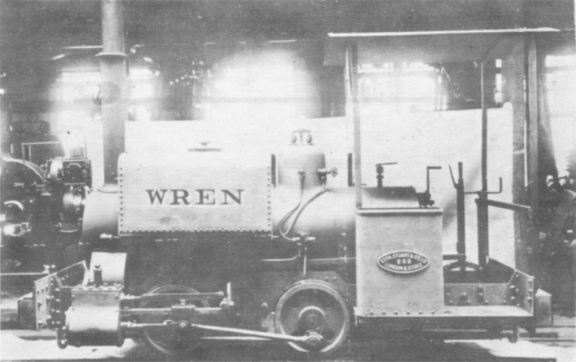
Kerr Stuart considered 888 of 1905, 2 ft. 6 in. gauge, to be a "Wren" although it bore more resemblance to the "Buya" design.
All "Wrens" up to and including no. 2423 had Stephenson link motion between the frames, and became known as the "old type" to distinguish them from the "new type" introduced with engine no. 2458 in 1915 which had outside Hackworth valve gear. Six "old type Wrens" were built after the introduction of the "new type", and one of the last ‘Wrens" built by Kerr Stuart – no. 4387 – was of the old design. It would appear that in most cases they were built for customers who already had an ‚ old type" locomotive and had placed a repeat order for an identical engine. In one case, with no. 3090, it is probable that an "old type" was built as the parts were on hand.
The "old type Wren" had the cylinders set in a horizontal position with their centre lines on a line passing through the centre line of the driving axle. The valves in steam chests above the cylinders were operated through rocking levers and a rocking shaft from inside Stephenson link motion. Instead of cylinder drain cocks, hexagon-headed plugs known as cylinder water plugs were fitted into tappings at the ends of each cylinder. The plugs had a one sixteenth inch hole drilled through the centre, which enlarged to three sixteenths of an inch diameter at the head of the plug. While this was a simple method of releasing water from the cylinders, it meant that steam blew continuously from the plugs while the locomotive was at work.
The reversing lever, attached to the left hand frame, was positioned fairly far back so that entry to the footplate from the left hand side was rather obstructed. The reversing shaft was set low in the frames between the leading and driving wheels, and a hand brake screw on the right hand side of the footplate applied brake blocks to the driving wheels only.
The low set boiler, the centre line of which was only 2 ft. 8½ in. above rail level, tended to give the "Wren" a rather squat appearance, though this was counteracted by the tall chimney whose top was 7 ft. 0½ in. from rail level. Inner fireboxes on the first "Wrens" were of copper but steel fireboxes quickly became standard, the copper type then only being supplied if specially ordered. A pair of Gresham No.3 combination injectors was fitted, one on each side of the boiler barrel, the steam valves for these being on each side of the dome. The dome also carried the blower valve at the rear, while a pair of safety valves of Kerr Stuart‘s standard pattern was fitted on top. There were few fittings on the firebox back — only the regulator quadrant and handle, one water gauge on the right hand side, and two try cocks on the left, as well as the fire door. On top of the firebox were a 2 in. whistle and a pressure gauge cock, the pressure gauge itself being attached to the weather screen.
Connecting and coupling rods were of circular cross-section, the ends of the rods only being machined; the middle portions were left in the "as forged" state and then painted. The eyes of the coupling rods and connecting rod big ends were fitted with split brasses retained in place by cotters. The crossheads were of the single slidebar type with the little end of the connecting rods working inside them as in normal locomotive practice.
The early "Wrens" had one-piece cast steel wheels which can be distinguished in photographs by the four holes in the wheel centre and the absence of balance weights. A change was soon made to cast iron wheel centres and steel tyres for, although it was possible to fit tyres to the one−piece wheels when they became worn, a large amount of metal had to be turned off the wheel treads before this could be done.
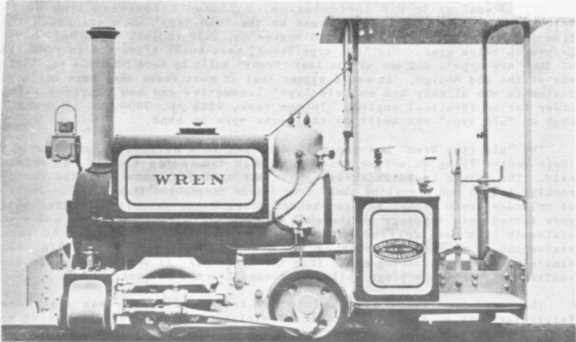
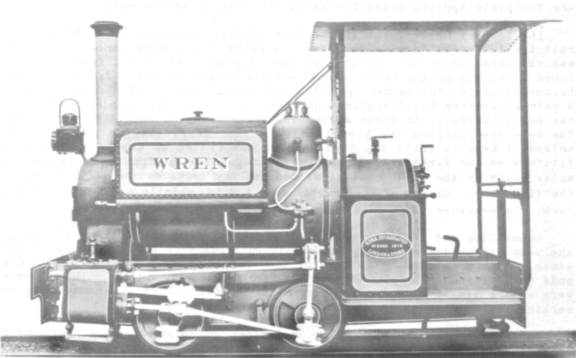
|
The standard "Wren". |
| Upper – "old type" 1018 of 1907, 60cm gauge. |
| Lower – "new type" 2462 of 1915, 2 ft gauge. |
A number of "Wrens" were equipped for oil burning, the usual arrangement being to provide an additional saddle tank containing 34 gallons of oil fuel over the firebox. A Kermode "Galva" type oil burner was located at the rear of the ashpan and tilted upwards into the firebox. In oilburning locomotives it is usual to line the lower part of the firebox with some refractory material to prevent the flame from the burner impinging directly on to the plates. To have used normal firebricks for this purpose on the "Wren" would have considerably reduced the already small firebox volume, so ¾ in. thick cast iron liners were fitted inside the lower part of the firebox. The bottom of the ashpan was also covered with a layer of ganister. For starting the oil burner "from cold" a cock was provided in the burner steam pipe for connecting the locomotive to an external supply of steam. If steam was not available, it was necessary to light a wood fire in the ashpan (there were no firebars with oil fuel equipment) and raise steam in the boiler until the pressure reached about 10 lbs. per sq. in. when the burner could be lit.
In 1915 the "Wren" design underwent considerable alteration, and outside Hackworth valve gear was substituted for the inside Stephenson link motion. "Wren" no. 2458 appears to have been the first Kerr Stuart locomotive fitted with the Hackworth gear. (No. 2395, a 7 in. by 12 in. "Tattoo" class 0−4−2 saddle tank, was the first of its type to be so fitted but, although carrying an earlier works number than 2458, it did not leave the works until 1917. The Hackworth valve gear is believed to have given good service, arid was no doubt much cheaper to produce than the Stephenson gear. Eventually it was fitted to most of the smaller locomotives of Kerr Stuart‘s standard range.
With the fitting of Hackworth valve gear, the removal of the reversing shaft to a position above the driving wheels became necessary. In order to perfl1it the shaft to pass below the boiler barrel. the latter was lifted 7½ in., the overall height of the locomotive being increased by the same amount. New cylinders, inclined at an angle of 1 in 13 to the driving axle. were attached to deeper frame plates which were now straight-topped. The steam chests were above the cylinders as before, but the valve port faces were horizontal and the valves were operated direct from the valve connecting rod of the Hackworth gear. As the cylinders were located at a higher level than on the "old type Wren", the increased ground clearance permitted the fitting of cylinder cocks and operating gear. At the same time the reversing lever was moved to the right hand side of the locomotive and attached to the bunker inner side plate. The brake column was also transferred to the left hand side of the engine, but brakes were still provided on the driving wheels only.
Marine type big ends were now used on the connecting rods as well as on each end of the coupling rods. The connecting rods were unusual in having forked little ends which embraced lugs on the crossheads, this no doubt being done in an attempt to obtain larger bearing surfaces for the crosshead gudgeon pins. Injectors of Holden and Brookes manufacture now replaced the earlier Gresham pattern. "New type Wrens" equipped for oil burning usually had oil tanks of 30 gallons total capacity fitted in place of the coal bunkers at the sides of the footplate.
Generally, stock orders for batches of about six "Wrens" were placed on Stoke Works. Manufacture of the parts proceeded but the locomotives were not usually completed until an order was received from a customer, i.e. until the required rail gauge was known. Items affected by the rail gauge consisted of the frame stays, buffer beams, footplating, smokebox saddle, axles, brake shaft, brake cross beam and reversing shaft, and in some cases the width of the awning.
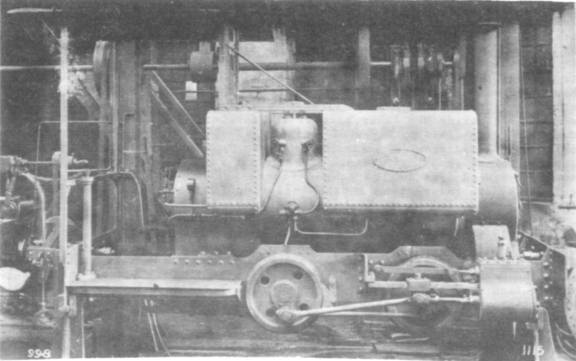
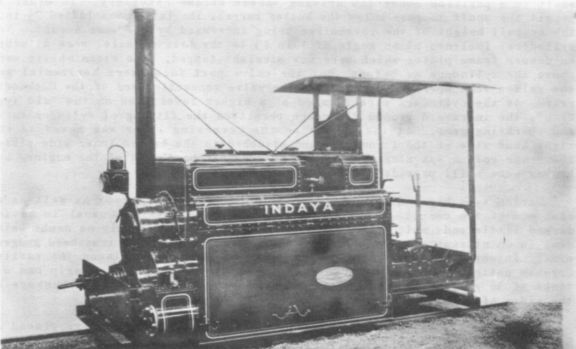
|
Oil-burning "Wrens". |
| Upper – 998 of 1907, 2ft 6in gauge. |
| Lower – 1041 of 1908, INDAYA, 915mm gauge. |
The first stock order was placed in February 1905 for six locomotives which were allocated works nos. 909 to 914. Apart from the new design of boiler, these engines had a slightly larger awning to that fitted to no. 888 and a hinged footplate to enable the driver to reach the ashpan. The first locomotive, no. 909, had trellis bars fitted to the tops of the bunkers for wood fuel, and was despatched on 21 July 1905 to the 2 ft. system of the Wassau Mining Company in the Gold Coast. No. 911 of 28 February 1906 was a 1 ft. 8 in. gauge locomotive for the Linares Lead Mining Co. Ltd. in Southern Spain. That it had outside frames was quite obvious but its extended smokebox may not have been so readily apparent, for the extension was in fact backwards. This enabled the boiler – which apart from the smokebox was standard with nos. 909, 910 and 912 – to be positioned five inches further back than on other "Wrens" so that the firebox throatplate could clear the driving wheels. The latter measured 1 ft. 61/8 in. between tyres, 1¼ in. less than the width of the firebox. (Another "Wren" with outside frames, no.1251 – see later paragraph – had a width between tyres of 1 ft. 81/8 in. and the boiler could thus be fitted in its normal position.)
As the "Wren" class was fairly widely distributed to customers throughout the world, it may be of interest to say something regarding individual engines. No. 995 (2 ft. gauge) was specially painted and despatched on 18 September 1907 to an exhibition in China along with some Kerr Stuart wagons and portable trackwork. No purchaser being found, it was returned to Stoke in June 1909 and sold to the San Paulo (Brazilian) Railway Co. Ltd. on 19 July 1909.
The first true "Wren" (see later note concerning no. 888) to be supplied to a home customer was no. 996, also a 2 ft. gauge locomotive, which went to the Markfield & Bardon Hill Granite Quarries of Ellis & Everard Ltd., near Leicester, on 24 June 1907. No. 998, the subject of one of our illustrations, was the first "Wren" to be fitted with oil burning equipment. It was built for 2 ft. 6 in. gauge and had a water capacity of 110 gallons in a large saddle tank. This locomotive was sent to Callao, Peru, through Matheson & Co., and left the works on 19 July 1907 painted khaki and lettered "L.P.P. Co. No.2". (On 4 August 1911, Kerr Stuart shipped out to the "L.P.P. Co." a 4−wheel hand-braked passenger car. The identity of the "L.P.P. Co." – ? in Lima – would be welcomed. – Hon. Ed.)
A 60 cm gauge locomotive, no. 1018, was shipped on 9 December 1908 to Singapore en route to the New Darvel Bay (Borneo) Tobacco Plantations Ltd. The illustration shows the engine specially painted for photographic purposes. This concern received four "old type Wrens", including the last one built, no. 4387.
Two interesting 915 mm gauge locomotives, no. 1041 INDAYA and 1042 GUARACY, were shipped via Montevideo to Cuyaba in Brazil on 23 September 1908. Apparently they were required for an unidentified steam tramway with gradients as steep as 1 in 20 for it has been recorded that tall chimneys were fitted in order to take the smoke above the roofs of the tramcars. The wheels and motion were totally enclosed as shown in the photograph. Oil fuel equipment was fitted as well as a 110 gallon capacity water tank. A small patent "Still" boiler accompanied these "Wrens" so that a supply of steam could be made available for starting the oil burners, and wood fires in the ashpans for this purpose would then not be necessary.
On 12 September 1910 a 3 ft. gauge "Wren", no. 1103 LAHAT, left Stoke for Lahat Mines Co. Ltd., Penang, Malaya. It was for use at a tin mine hauling 1 ft. 6 in. gauge wagons on a parallel track by means of a wire rope. A further locomotive, no. 1191, was supplied to the same customer on 8 April 1911.
No. 1248 MAIPOORI was built with tyres 5 in. wide having flanges 1½ in. deep for running on 2 ft. gauge wooden rails. The fuel racks round the bunkers are stated to have been provided for "a heavy wood fuel". One injector and a long stroke pump driven from the right hand crosshead were provided. The illustration shows MAIPOORI before being shipped to Demerara, British Guiana, on 22 November 1912. Its stay there, however, must have been short as it was back at the works in Stoke by June 1914. Alterations were made to make the locomotive suitable for normal track of 60 cm gauge, after which it was despatched on 14 July 1914 to the City of Santos Improvements Company, Brazil.
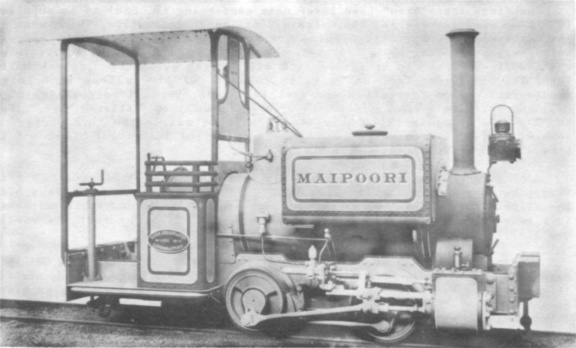
Detail alterations.
"Wren" 1248 of 1912, MAIPOORI, 2 ft. gauge, has wide flange tyres and racks for wood fuel.
Another 2 ft. gauge "Wren", no. 1249, carrying the name SIR JAMES on brass nameplates went to the Aden Port Trust on 26 February 1913. It would be interesting to know how long the railway survived, for the metre gauge Aden Railway laid some years later had a comparatively short life. An interesting outside framed "Wren" built for 1 ft. 10 in. gauge carried makers no. 1251 and the name MOSCA. It was supplied through Boiling & Lowe and left Stoke on 23 September 1913 for the mining concern of Mason & Barry Ltd. in Portugal, a company better known for its 3 ft. 6 in. gauge railway. (According to Mason & Barry records MOSCA was employed on the 122nd level of the huge opencast ironstone mine – now nearly worked out – at Sao Domingos. It was withdrawn from service underground about 1933, and then completely overhauled about 1954 before installation in a small shed in a disused quarry. Officially it is classed as ‘in reserve
’ but it is in such splendid condition that we should consider it as ‘preserved‘. – Hon. Ed.)Only two "Wrens", both 2 ft. gauge, were completed in 1914, no. 1250 for the Sinai Mining Co. Ltd. at Suez, and no. 1252 for MacDonald Gibbs & Co. at the War Department Fovant Camp, near Salisbury. On 22 January 1914 Kerr Stuart works numbers were increased by 1000 and the next batches of "Wrens" turned out in 1915 carried makers nos. 2386-2393 and 2418-2423. All were 2 ft. gauge locomotives, except no. 2387 which was built for the 75 cm gauge system of the Borneo Co. Ltd. and despatched to Bangkok on 20 February 1915. No. 2387 had its saddle tank raised 3½ in. clear of the boiler barrel and was fitted with injectors to work with feedwater at a temperature of 80−90 degrees F. Lifting the saddle tank was done to allow a current of air to pass underneath in an attempt to obtain cooler feedwater, although this was probably of doubtful value as the boiler was lagged anyway. The trouble was almost certainly due to the sun making the tank plates so hot that the water was heated up. I believe that the War Department had this trouble with L.M.S. "8F" 2−8−0‘s in Persia during World War 2, and cured it only by fitting injectors capable of dealing with hot feedwater.
Nos. 2386 and 2390 went to Balfour, Beatty & Co. Ltd. at Ripon, Yorkshire, and are believed to have been used on the construction and operation of the military camp there. Nos. 2391, 2393 arid 2419-2422 were delivered to Harper Bros. & Co. at Catterick Bridge, Yorkshire, again it is believed for camp construction work. (Harper Bros. & Co., consulting engineers of Richmond, Yorkshire, were ‘agents for the War Department‘ here. – Hon. Ed.) It would be interesting to know the subsequent history of 2388 and 2392 which were shipped to W. Cubitt & Co. in the Falkland Islands on 3 March 1915. It is possible that they may have been employed on the harbour works in Port Stanley which at that time was a Naval coaling station.
The next batch of "Wrens" ordered were allocated works numbers 2458-2465, the stock order of May 1915 stating that they were to have ‘the simplified valve gear' No. 2458 was shipped on 8 September 1915 to Victoria Point, Burma, for an unknown destination in Siam, and has subsequently been recorded as being owned by The Bangrin Tin Dredging Co. Ltd. No. 2462 of this batch was the locomotive used for the official photograph taken to show the new design incorporating the Hackworth valve gear, and was despatched to Archangel, Russia, per Martin Olsson & Co. on 2 November 1915. Equipment was also sent out for firing the locomotive on naphtha, the oil tanks being made to replace the side coal bunkers – an arrangement which became standard for oil fired "new type Wrens". All locomotives of this batch were built for 2 ft. gauge.
The subject of our heading, No. 3105, was the last locomotive of a batch of four, 3102-3105. ordered on 25 October 1917. All were of 2 ft. gauge, hut 3102 was an "old type" – possibly another case of using up stock parts. as all four locomotives were ordered by the War Office. No. 3105, sent to the Resident Engineer at Kidbrooke Aerodrome on 27 April 1918 for construction work, joined 3102 (despatched 18 December 1917) and 3103 (14 February 1918). (3103 had been ordered for the Didsbury Aerodrome, near Manchester, but appears to have been diverted to Kidbrooke. – Hon. Ed.) At some date after January 1933 No.3105 was purchased by the Leighton Buzzard Brick Co. Ltd., of Potsgrove, Bedfordshire, where it carried the name HAIG. Various items of spares were supplied by Kerr Stuart and Hunslet over the years, the last so far as can be traced being a set of firebars in May 1938. The locomotive was scrapped in February 1952, by which time its owners had dispensed with their railway system and removed the track.
In July 1918 the Ministry of Munitions placed an order for six 2 ft. gauge "Wrens" which were given works numbers 4001-4006. (Works numbers had been advanced by 870 during the early part of the year.) An order for a further twelve, 4013-4024, was placed a month later, this batch being earmarked for aerodrome construction work. In Kerr Stuart‘s Engine Book against 4006 and 4013-4015 is a manuscript entry ‘S.A.R. Delagoa Bay‘ which would appear to indicate shipment to the South African Railways through Delagoa Bay. (Durban was the port of shipment for seven Kerr Stuart 4−6−2 tanks built for the S.A.R., and Algoa Bay for a pair of 4−6−0’s.) 4006 was later owned by The Eastern Province Cement Co. Ltd., near Port Elizabeth, and had a new boiler from Hunslet in 1935. This company received from Hunslet in 1949 a 2 ft. gauge 2−8−2 tender locomotive, the design of which was based on Kerr Stuart‘s 2−8−2‘s built for the Gwalior Light Railway in India.
(Some 'little locos‘ are recalled as working at the R.A.F. establishment in Sheffield, and I feel certain that 4006 and 4013-4015 were in fact delivered here new. Mention of ‘Delagoa Bay‘ in the records suggests that Kerr Stuart handled the shipment but, although all other overseas despatches are accounted for in their Shipping Specification ledgers, 4006 and 4013-4015 are conspicuous by their absence. Perhaps our South African readers will let us know whether these four "Wrens" ever did work on the S.A.R. Lourenço Marques would appear to be the appropriate port for ‘Delagoa Bay‘ ‚ and Port Elizabeth similarly for ‘Algoa Bay‘. – Hon. Ed.)
During 1922 and 1923 the firm of R.H. Neal & Co. Ltd. purchased no fewer than twenty-seven 2 ft. gauge "Wrens", of which all but three were delivered to Barkingside, Essex; it is believed that they were used on a sewer construction scheme. Several of these locomotives were later bought by the Devon County Council, including no.4250 which acquired the name LORNA DOONE; it is now preserved by the Birmingham City Museum and Art Gallery. Another D.C.C. "Wren", no. 4260 PIXIE, has been privately preserved by the Industrial Locomotive Society. (The third "Wren" to be preserved in this country, no. 3114, is to be found at Hindlip Hall, near Worcester. It was in a deplorable state when rescued by our member Alan Maund in May 1959, but has since been restored to its original condition. – Hon. Ed.). Two others of this batch, nos.4253 and 4269, were later purchased by Sir W.G. Armstrong, Whitworth & Co. Ltd., and used on the construction of the East Coast Main Trunk Railway on the North Island of New Zealand. Unfortunately,, only the section along the Bay of Plenty between Paeroa and Taneatua was completed, and this survives as the Taneatua branch. No.4269 later went to the Public Works Department for railway construction work at Inangahua, and both locomotives are later recorded with the Puponga Coal Company at Collingwood at the northernmost tip of the South Island. Another "Wren" to work in New Zealand was no. 1193 which was painted black with red lining, and despatched to Auckland on 28 October 1911 per Geo. H. Penney & Company. The first owner is said to have been the Tokomaru Bay Farmers Freezing Company (although this does not match up with "F.S.C." as given in Kerr Stuart‘s records. – Hon. Ed.) and the locomotive appears to have been one of the first oil-burners in New Zealand; it spent its whole life under several owners on a 2 ft. 6 in. gauge railway at Tokomaru Bay, which is about fifty miles from the north-east tip of the North Island.
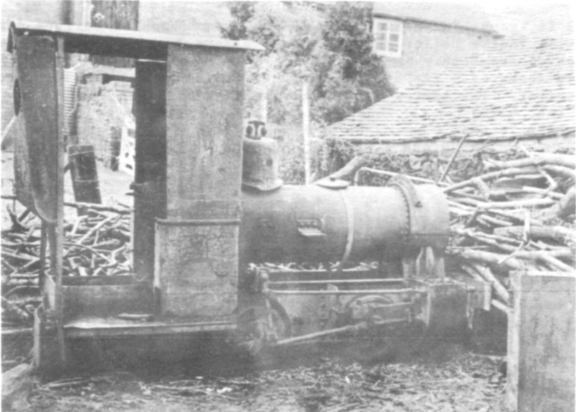
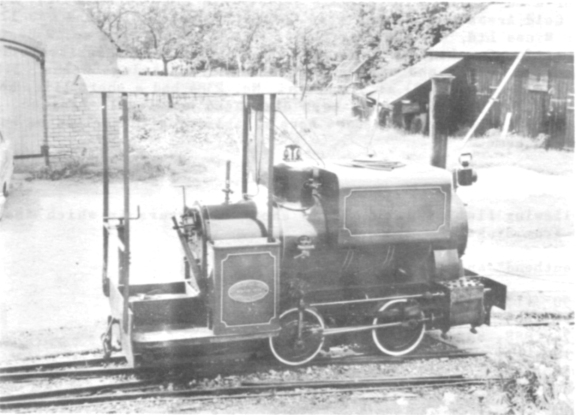
We are assured that both these photographs by member Alan Maund depict "Wren" 3114 of 1918. Before .. at P. Beard's Hill Farm at Brockamin, Worcs., in 1959. and .. After .. restoration by Alan Maund at Hindlip Hall, near Worcester, in 1962.
Three 2 ft. gauge "Wrens", nos. 4276-4278, had special boilers designed to comply with Indian Boiler Regulations, and were despatched on 27 November 1922 for use on the Bombay Back Bay Reclamation Scheme. Two 18 in. by 24 in. 0−6−0 saddle tanks of 5 ft. 6 in. gauge had left Stoke for the same contract ten days earlier. The Admiralty took delivery of a fourth 2 ft. 6 in. gauge locomotive (no. 4328) for the Royal Victoria Yard at Deptford on 31 October 1927, where two other "Wrens" – nos. 1104 of 1909 and 2472 of 1916 – had been supplied after no. 888. No. 4328 had a copper inner firebox and a feed pump instead of the left hand injector.
The last "Wren" to be, sold by Kerr Stuart was no. 4330 which went to Brazil on 6 November 1929. No. 4387, which was an "old type", though having a higher works number, had been despatched three years earlier. Kerr Stuart still had one "Wren" (no. 4331) on their hands when they closed down in July 1930. Its boiler had been steam tested on 6 September 1929 and the locomotive was brought to Leeds by Hunslet. It was sold through Robert Hudson Ltd. to Siamese Tin Mines Ltd., and left Leeds on 21 March 1932 carrying Hunslet works number 1702.
Three of the "Wrens" built by Hunslet were supplied to Robert Hudson Ltd., no.1703 for a customer in the Straits Settlements (18 October 1934), no. 1775 for Tarkwa Gold Areas Ltd. in the Gold Coast (20 April 1935) and no.1797 for Siamese Tin Mines Ltd. (24 September 1935). Last of all came no.2384 for the National Smelting Co. Ltd. at Avonmouth (30 June 1941). This locomotive was built without an awning and with a short chimney, joining "Wrens" 3104 and 3128 (both dating from 1918) at Avonmouth. No.2384 had a short life, however, being cut up in 1955 after it had been displaced by diesel traction, a form of motive power in which Kerr Stuart were establishing themselves as builders when their end came.
The following list of locomotives shows the years in which they were despatched from Stoke.
"Southend" and "Buya" (9)
1903 : 850 (1)
1904 : 868, 869 (2)
1905 : 874, 888, 889, 915 (4)
1909 : 1106 (1)
1927 : 4405 (1)
(Although no.888 was classed as a "Wren" by Kerr Stuart it had a wide firebox and was more appropriate to the "Buya" class. Similarly, no.915 shows more affinity to the "Southend" than the "Wren" class. The first true "Wren" was no.909.)
"Wren" class (old type) (58)
1905 : 939, 910 (2)
1906 : 911-913 (3)
1907 : 914, 995-998, 1015, 1016 (7)
1908 : 1017, 1018, 1041, 1042 (4)
1909 : 1043, 1044, 1104, 1105 (4)
1910 : 1099-1101, 1103 (4)
1911 : 1102, 1188, 1190-1193 (6)
1912 : 1194, 1195, 1248 (3)
1913 : 1247, 1249, 1251 (3)
1914 : 1250, 1252 (2)
1915 : 2386-2393, 2418-2423 (14)
1916 : 3020 (1)
1917 : 3090, 3102 (2)
1920 : 4207, 4208 (2)
1926 : 4387 (1)
"Wren" class (new type) (109)
1915 : 2458-2462, 2464, 2465 (7)
1916 : 2463, 2466-2477 (13)
1917 : 3026 (1)
1918 : 3103-3105, 3114, 3128, 4001-4006 (11)
1919 : 4013-4024, 4031 (13)
1920 : 4154-4158 (5)
1921 : 4159-4163 (5)
1922 : 4246-4271, 4273, 4274, 4276-4278 (31)
1923 : 4275, 4290-4295 (7)
1924 : 4296-4299 (4)
1925 : 4324 (1)
1927 4325, 4328 (2)
1928 : 4326 (1)
1929 : 4327, 4329, 4330 (3)
1932 : 4331 (sold as Hunslet 1702) (1)
1934 : Hunslet 1703 (1)
1935 : Hunslet 1775 and 1797 (2)
1941 : Hunslet 2384 (1)
It is doubtful if any "Wrens" now remain in service, even in remote parts overseas, but it is pleasing to note that at least four (1251, 3114, 4250 and 4260) of these fine little products of Kerr Stuart‘s California Works still survive. Acknowledgements are due to the Hunslet Engine Company Ltd. for permission to publish this article and for the use of official photographs, and to Brian Whebell of Greymouth, New Zealand, (See also Mr A.G. Wells' "Letter to the Editor" in this issue. – Hon. Ed.)